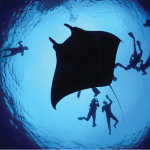Manta rays are a popular focal species within the global marine tourism industry. Their popularity and tourism value helps contribute to increased protection for these majestic creatures.
However, without appropriate management, tourism itself can be detrimental to manta populations. Potential impacts can be minimised by adopting well-designed interaction guidelines.
By giving mantas space, and by interacting with them in a non-threatening way, divers and snorkelers can enjoy much longer and spectacular encounters.
We have developed the following guidelines to help tourists and operators maximise their encounters with manta rays.
Manta Ray Code of Conduct
- BRIEFING – All guests should receive a manta ray briefing, and understand that in order to minimise impacts they must follow the guide and adhere to their instructions at all times. By following these guidelines, your encounter is likley to be longer and more spectacular.
- OBSERVE ONLY – Do not approach individuals closer than 3 metres, unless the manta approaches of their own free will. Refrain from touching or riding mantas, which can rub off protective mucous coatings and cause injury.
- BEHAVIOUR – Avoid restricting the manta’s normal movement or behaviour. Approach the manta slowly. Do not chase mantas; longer and closer encounters normally result from waiting patiently and allowing the mantas to approach.
- POSITION – Divers should stay on or near to the rubble, sand or boulder bottom. An open water column is necessary for mantas to manoeuvre, and they are more likely to approach closer. Form a semi-circle with your group, allowing the manta a clear escape path.
- BUBBLES – Be aware that exhaled bubbles can startle mantas swimming overhead.
- PHOTOGRAPHERS – If taking photos or videos, do not overlook these rules or other divers in order to get a good picture. Avoid excessive flash photography, and let the mantas come to you.
- IMPACTS – Be aware of buoyancy, avoid accidentally knocking or kicking the reef, and do not touch the reef unnecessarily. Do not take anything from the underwater environment.
Operators can take further steps to minimise negative impacts to mantas by restricting encounters with a single animal to a maximum of 10 minutes, and limiting group sizes to 8 divers.
Under specific circumstances the following recommendations may apply:
- During night dives, divers should shine lights up into the water column to attract plankton, and avoid dazzling mantas and other divers.
- Underwater motorised diver propulsion vehicles should not be used around mantas.
- In locations subject to high currents, snorkelers and divers are advised to enter the water up-current and drift toward the manta or aggregation. A signalling device such as an SMB is recommended.
We would like to acknowledge the following organisations whose work has been incorporated into these guidelines:
- PADI’s Project AWARE
- The Shark Trust
- The Ocean Recreation Council of Hawaii
Tell us your thoughts in the comments below. Do you have any suggestions or ideas to improve these guidelines? Or do you have any stories of your own attempts to interact responsibly with mantas. Let us know in the comments below.



